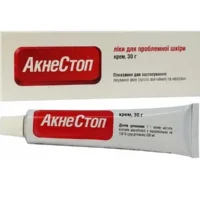Description
Anastrozole Coated Tablets 1 mg. №28
Composition
Active ingredient: Anastrozole 1 mg.
Other ingredients: lactose monohydrate, povidone, sodium starch glycolate, magnesium stearate, hypromellose, macrogol 300, titanium dioxide (E171).
Mechanism of Action
Anastrozole is a selective aromatase inhibitor that inhibits the enzyme aromatase, responsible for converting androgens to estrogens. By reducing estrogen levels, Anastrozole helps in slowing or halting the growth of hormone receptor-positive breast cancer cells.
Pharmacological Properties
Anastrozole, through its mechanism of action, exerts its pharmacological effects by specifically targeting the aromatase enzyme, thereby modulating estrogen levels in the body.
Indications for Use
Anastrozole tablets are indicated for the adjuvant treatment of postmenopausal women with hormone receptor-positive early breast cancer to reduce the risk of cancer recurrence and improve survival rates.
Contraindications
Do not use Anastrozole tablets if you have a known allergy to anastrozole or any of the components present in the formulation. It is advisable to consult with a healthcare provider before initiating treatment.
Side Effects
Common side effects of Anastrozole may include hot flashes, joint pain, fatigue, mood disturbances, and osteoporosis. Serious but rare side effects may include bone fractures and cardiovascular events.
Usage Instructions
Adults: The recommended dosage of Anastrozole is 1 tablet daily, with or without food. It is essential to adhere to the prescribed dosage and follow the instructions provided by the healthcare provider for optimal outcomes.
Benefits Compared to Analogues
Anastrozole has demonstrated comparable or superior efficacy to tamoxifen in the adjuvant treatment of early breast cancer. Clinical trials have shown improved disease-free survival with Anastrozole compared to tamoxifen, indicating its potential as a first-line treatment option.
Suitable Patient Groups
Anastrozole is suitable for postmenopausal women with hormone receptor-positive early breast cancer. It is not indicated for premenopausal women or individuals with unknown hormone receptor status.
Storage and Shelf Life
Store Anastrozole tablets in a cool, dry place away from direct sunlight. Ensure proper sealing of the packaging to protect from moisture. Check the expiration date on the packaging and do not use the product beyond the stated shelf life.
Packaging Description
Anastrozole tablets are typically packaged in blister packs to maintain product integrity and ensure individual dosing accuracy. The packaging should be intact and undamaged upon purchase.
Clinical Evidence and Proven Effectiveness
Anastrozole has been supported by clinical studies demonstrating its efficacy in the adjuvant treatment of hormone receptor-positive breast cancer. Notably, the ATAC trial showed improved disease-free survival with Anastrozole compared to tamoxifen, emphasizing its role in improving patient outcomes.





